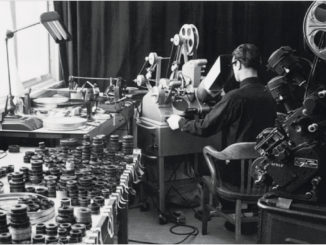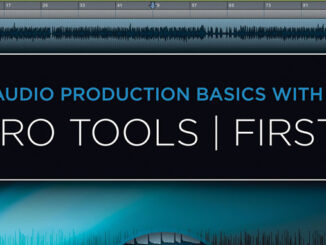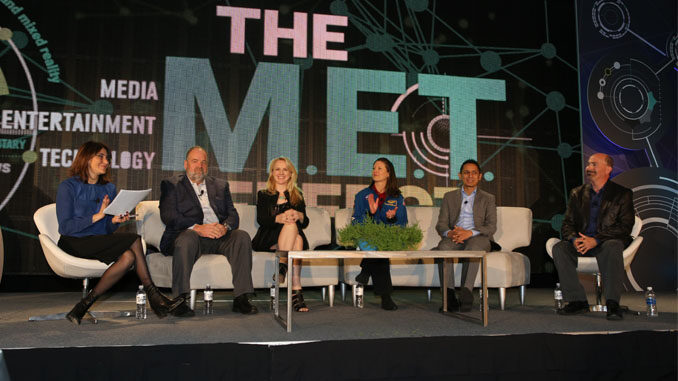
by Mel Lambert
The NAB Show, held from April 22 through 27 at the Las Vegas Convention Center, once again offered a unique opportunity for post professionals to update themselves on new sound and picture technologies, and scope out the latest and greatest offerings in the spacious exhibition areas. The gathering attracted a reported attendance north of 103,000 from 161 countries, with over 1,700 exhibitors. Adopting once again a core theme of “Where Content Comes to Life,” the convention’s focus remains on the creation, post-production and delivery of content via terrestrial, satellite, broadband and other direct-to-the-consumer distribution channels. Post tools for producing 4K, HDR, high frame rate and wide color gamuts images with multi-channel immersive soundtracks remain in continual development, with collaboration across multiple disciplines enhancing our creativity and efficiency.
As NAB president/CEO Gordon Smith stated in his annual State of the Industry address, “We are witnessing thrilling innovations in 4K UHD and next-generation television; the story of broadcasting is rooted in innovation, inspiration and imagination. Because of its unparalleled reach, the highest-quality content will always find its way to broadcast TV – even in this era of unprecedented competition for eyeballs, broadcast TV airs 90 of the top 100 most-watched shows every week.”
With fast-evolving technology, “We’re living in a world of our own invention,” Smith added. “Behavior and business have merged to redefine content, workflows and revenue streams. This is ‘the MET Effect’ – the convergence of Media, Entertainment and Technology – [which defines] a cultural phenomenon fueled by hybrid solutions and boundless connectivity that’s changing the very nature of how we live, work and play, from mixed reality to the future of cinema.”
The next-generation ATSC 3.0 TV standard also is achieving mainstream status, with tools and delivery mechanisms falling to place. As Smith stated, “This is the world’s first broadcast standard that offers the advantages of broadcast and broadband. With Next Gen TV, we see the seamless convergence of over-the-air and over-the-top.” A voluntary rollout is expected by year-end and possible US deployment in 2018, with HDR and immersive sound opportunities.
Next Gen TV will deliver the benefits of UHD TV, as well as interactive features and customizable content. “Viewers can also look forward to more choices, more channels and more flexibility, along with improved reception [via ATSC 3.0],” Smith concluded. “New technologies are giving us the ability to improve the delivery of our content.”
By way of an example, NASA debuted the first-ever live 4K video stream from space during the session “Reaching for the Stars: Connecting to the Future with NASA and Hollywood,” with astronauts Dr. Peggy Whitson and Jack Fischer conversing with Amazon’s CEO/co-founder Sam Blackman live from the International Space Station, and demonstrating zero-gravity experiments. A subsequent discussion panel moderated by Carolyn Giardina from The Hollywood Reporter covered technological advancements in space exploration and the vital role played by video and camera technologies.
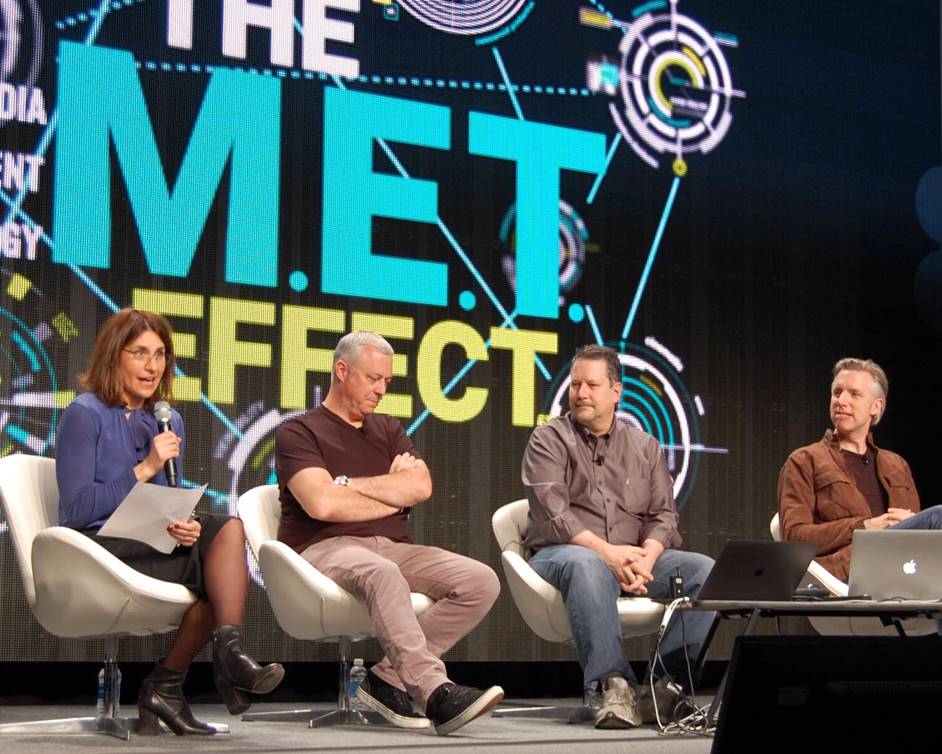
Staying with the space theme, a session entitled “The Force Returns: Rogue One: A Star Wars Story” examined how Lucasfilm executed the film’s exhilarating visual effects with Hal Hickel, ILM’s animation supervisor, John Knoll, ILM’s senior visual effects supervisor, and supervising sound editor/sound designer Matthew Wood sharing insights on virtual production and how the latter mastered the immersive soundtrack. More than 1,700 VFX elements were developed for the film, including new spaceships, weapons and Droids, for which Skywalker Sound designed distinctive, original sounds. The session also addressed how ILM and Skywalker Sound balanced new and classic elements through virtual production, proprietary Flux software and an innovative production pipeline.
Also of relevance to post professionals was the two-day “Future of Cinema” summit, co-organized by NAB and SMPTE, which comprised a number of interesting sessions, ranging from cloud technology in global distribution and Lightfield options for content production through immersive audio and consumer option on artistic intent to next-generation cinema, including a detailed IMF case study and virtual-reality scenarios. As we know, cinema is no longer confined to a theatrical setting; consumers now seek content via myriad distribution outlets, with creators working to maintain artistic intent in an ever-evolving landscape.
A session entitled “How It Gets There – The Unintended Consequences of Progress,” with representatives from Dolby Laboratories, Walt Disney Studios, Warner Bros., Fox Entertainment, Barco and Deluxe Digital, reviewed the creation of Digital Cinema Initiatives (DCI) in March 2002 and the first Digital Cinema System specification from July 2005; SMPTE standards supporting these specifications were completed in 2009, with the cinema industry now moving to distribution of DCPs that conform to these standards – the “SMPTE DCP” – in both the US and some overseas territories. Meanwhile, immersive audio and enhanced image capabilities are available to convey filmmakers’ creative visions, while mastering and distribution systems are struggling with the increasing number of different soundtrack formats.
“Next Generation Cinema: How You Hear It – Immersive Audio,” with participants from Walt Disney Studios, Dolby Laboratories, DTS, Auro, Fox and Sony Pictures, reviewed the genesis of multi-channel soundtracks, since demonstrations of stereo audio during the mid-1930s, and a variety of stereo and multi-channel formats beginning in the 1950s. Matrix-encoded and discrete Dolby Stereo debuted in 1975, followed in 1992 by Dolby Digital 5.1; when launched in the early 2000s, Digital Cinema offered a discrete 5.1-channel mix. And 7.1-channel was added several years later, while in 2012 Dolby Atmos immersive audio started to be deployed. Now Barco AuroMax and DTS:X are available as alternative immersive audio solutions. Several re-recording mixers and sound editors discussed how content serves this diverse exhibition environment as well as future options.
A two-day conference entitled “Next-Generation Media Technologies,” co-produced with Entertainment Technology Center at USC, spotlighted cutting-edge technology reshaping the creation, distribution and consumption of entertainment content, including the emergence of artificial intelligence, innovations in cloud technology and the development of AR and VR. The latter subject was the focus of “A Look at the Evolving Trends in VR and AR Audio,” moderated by Linda Gedemer from Source Sound VR, including current audio tools, trends animating VR audio and wish lists for future technology. With audio toolsets changing frequently, it was agreed that a handful of tools – such as a game tool Wwise and Dolby Atmos – are more widely accepted.
Another ETC@USC session, “Thought Leadership for Key Players in the Industry,” moderated by Walden Pond’s Wendy Aylsworth, considered the current cloud initiatives at Microsoft, Google, Adobe and Avid, and the challenges in making these services a reality. Because the Cloud offers multiple workflows, each user looks for different end-user benefits and ROI.
According to Bill Roberts, who heads up Adobe’s Creative Cloud: “Our stories are still anchored on the desktop,” including editing, graphics and visual effects. The transition to the cloud, he stated, “should be in bite-sized chunks,” to incentivize users and make the desktop experience better; he also revealed that Adobe is looking to apply machine learning/AI to the creative space. Avid Technology president Jeff Rosica opined that the Cloud is about “flexibility, elasticity and agility, not just operational and capital efficiencies. Security is the reason people choose the cloud,” he added. Whether it is uploading fresh web content; moving files from one location to another; or searching for a specific filename from the database with a grep command, the flexibility and agility provided by the cloud can be very advantageous for admins.
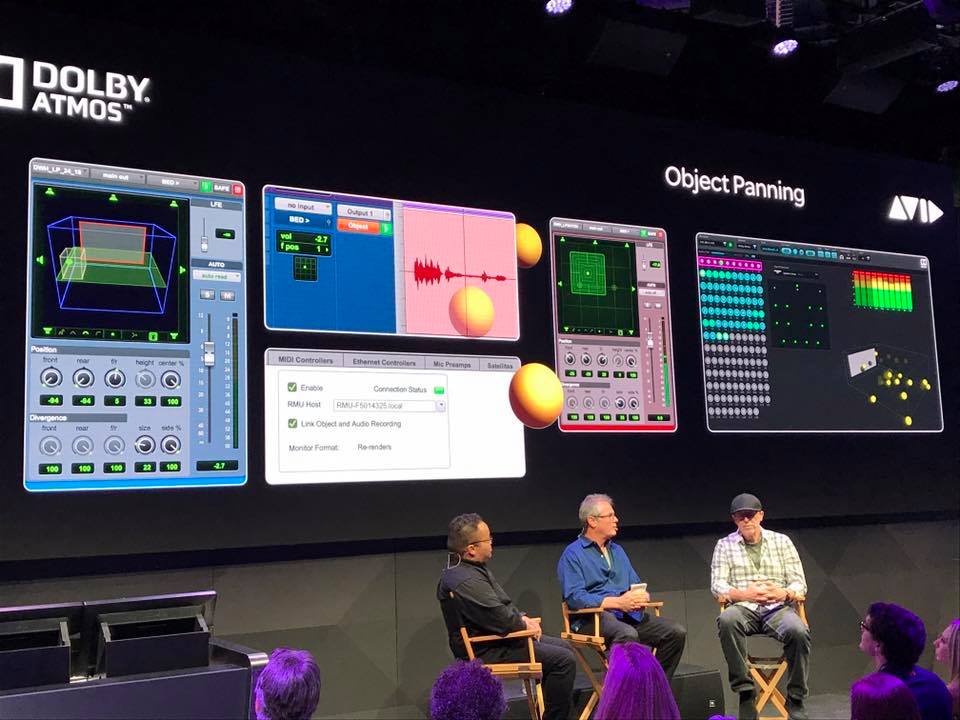
Technological Developments at NAB Show
Focusing on DAW and NLE developments, Avid Technology announced native support for the new 7.1.2 Dolby Atmos format, plus a number of upgrades for Pro Tools, including new panning software for object-based audio and the ability to switch between object and buss outputs. Pro Tools HD is described as the only DAW to natively support Atmos mixing for the 10-channel 7.1.2 format in-the-box. Users can now address all Atmos objects from one or more Pro Tools systems, as well as the option to move between the object and bed mixes, with a 7.0.2 stem option as an internal format option. Avid also will be adding re-recorder dubbing for Atmos metadata, whether it is for automation or object metadata into the Dolby RMU. Also added: integration for Atmos workflows for the control surfaces like the Avid S6, the aim being to enable production of a full Atmos theatrical mix completely in the box, with no console required; a free version of Media Composer video editor, powered by MediaCentral Platform; and a new version of Pro Tools|First, with a graphically enhanced manual and user tutorials.
Latest updates to Adobe Creative Cloud include an Essential Graphics panel within Premiere Pro for creating titles and motion graphics that can be placed directly on the Program monitor with controls to change font, size and text color. Motion Graphics templates created in After Effects allow picture editors to add titles, animations and lower thirds to videos that can be shared via Creative Cloud Libraries. Essential Sound Panel for Premiere Pro and Audition is said to enable users to achieve audio mixes and sound processing without the need of a dedicated audio engineer. Multi-channel workflows in Audition break out files into separate clips, or select them into custom channel configurations, ranging from 5.1-channel and Ambisonics, to unique MXF arrangements used by broadcast and video facilities.

Blackmagic Design unveiled DaVinci Resolve 14, a major release that is said to offer a 10-times performance improvement, a new post suite with built-in Fairlight audio, plus multi-user collaboration tools. In essence, the update to DaVinci Resolve integrates editing, color correction and audio tools to provide a parallel workflow, with a price reduction from $995 to $299. The Fairlight low-latency audio engine is designed to work with 192 kHz/96-bit and can deliver up to 1,000 tracks with real time EQ, dynamics processing and plug-ins on every track; it also handles spatial formats such as 5.1, 7.1, DTS multi-dimensional array, Dolby and even 22.2.

Bluefish444 demonstrated enhanced support of Adobe Creative Cloud components utilizing its new KRONOS video, audio and data I/O card that offers GPU-accelerated performance for 4K HDR and Video Over IP workflows. The firm’s Adobe Mercury Transmit support for Premiere Pro CC, After Effects CC, Audition and other tools is said to improve performance for demanding workflows that require real-time video I/O from UHD and 4K high frame rate sequences, with dual-link 1.5 Gbps SDI links plus Quad Link 1.5 Gbps and 3 Gbps SDI.
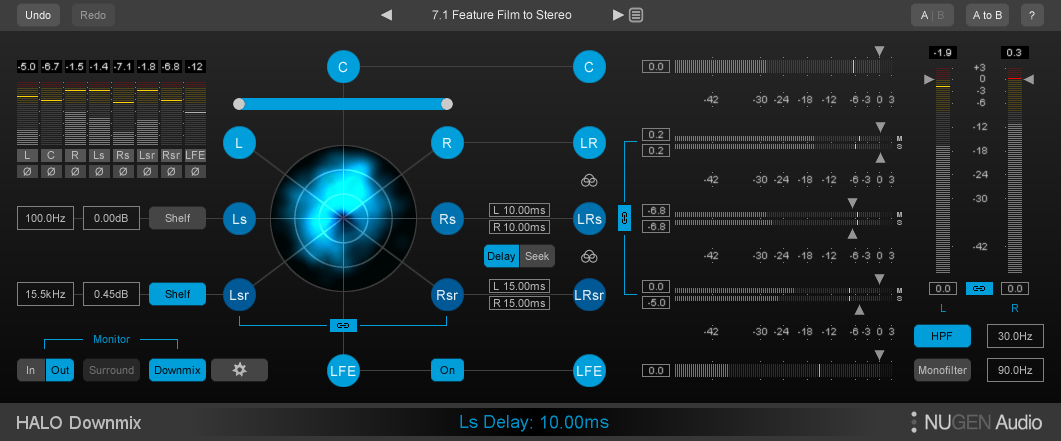
Turning to DAW plug-ins, NUGEN Audio unveiled the new Halo Downmix that provides downmixing of feature-film and 5.1-channel mixes to stereo, with GUI controls for relative levels, timing and direct-versus-ambient balance. Dialogue level can be maintained effectively with phantom-center ratio controls and management of excess ambient sound from rear channels. Low frequencies also can be regulated to ensure appropriate levels in down-mix, as well as timing artifacts in surround channels. Also to be seen: Loudness Toolkit 2 and AMB Processor for additional loudness control.
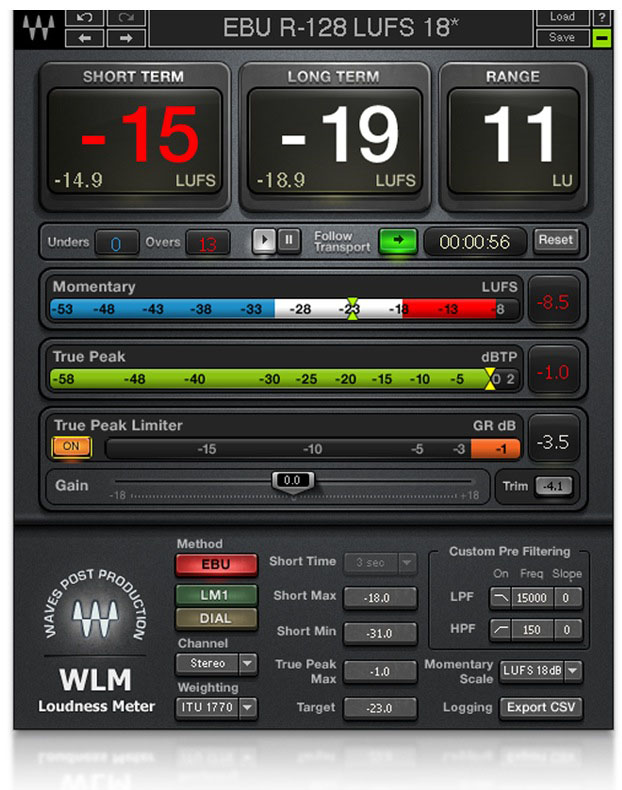
Waves Audio demonstrated an upgraded version of its Waves Loudness Meter Plus plug-in, which now offers Compliance with current ITU, EBU and ATSC specifications, including new pre-sets meeting ARIB TR-B32, OP-59 and current Discovery Channel requirements. Also available are Momentary, Short Term, Long Term and True Peak readouts, as well as a warning and logging system that tracks user levels and provide an alerts if they have exceeded them or fallen short. Gain and Trim controls are available for loudness-level correction and a True Peak Limiter.
Dolby showcased its new Atmos Production and Mastering suites for immersive-audio production, now available for Avid Pro Tools 12 users that prepare cinematic and consumer-release media. For the former, the 9.1 Atmos bed and accompanying panning metadata will continue to be rendered in the Rendering and Mastering Unit (RMU), to provide DCP elements for theatrical distribution. The Atmos Production Suite replaces the local renderer plug-in, which previously was only available on a controlled basis, and provides editorial and premix functionality for film and TV content, along with an end-to-end VR workflow. It includes an Atmos Panner for Pro Tools, an Atmos Renderer, an Atmos Monitor and an Atmos VR Transcoder. The Mastering Suite adds HT-RMU software for digital delivery or Blu-ray media.
DTS showed DTS:X Creator Suite, a range of software tools for mixing and delivering immersive-audio content; it includes the DTS:X Encoder Suite, DTS Headphone:X Monitor and MDA Tools. The Encoder Suite handles encoding, modification and verification of audio bit streams prior to multiplexing and authoring, with support of up to 11.1-channel and object-based encoding. Headphone:X Monitor lets users mix immersive content without height speakers, while MDA Tools create object-based, immersive content using the DTS:X ecosystem, a royalty-free, open-standard technology.
Linear Acoustic unveiled new audio monitoring and authoring tools for immersive 3D audio in compliance with the ATSC 3.0 specification. AMS simultaneously delivers audio for ATSC 3.0 broadcasts and 5.1/two-channel audio for ATSC 1.0, OTT or mobile delivery, using smart metadata and the firm’s APTO loudness control. A web interface provides control of MPEG-H’s interactive features, and builds presets for different listening experiences. The system accepts SDI, AES/EBU and analog inputs, plus 16 channels of AES67 audio over IP.
Minnetonka Audio announced AudioTools Server v4.5, which includes new GUI plus feature enhancements and new processing modules. An enterprise-level platform for automated and unattended file-based audio processing, AudioTools Server is supplied with loudness control, Dolby E automation, movie adaptation and other functions. Workflow Editor offers tools for setting up and configuring server workflows; a new Web Client allows users to view the server processing queue through any compatible web browser.
Prime Focus Technologies launched CREATE for end-to-end production management from screenplay to production with a connected supply chain. The system will allow users to “plan and manage production better, and make higher quality creative decisions quicker leading to enhanced operational efficiencies by reduced rework,” according to company sources, to “ensure continuity, access to assets, approvals and inventory management seamlessly.” CREATE is seen as an extension of the firm’s Media ERP software.
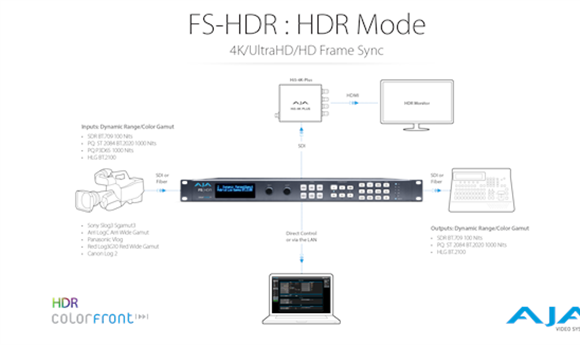
Focusing at audio and video recorders, AJA Video Systems announced the Ki Pro Ultra HD recorders for video formats that include Apple ProRes and Avid DNxHD MXF, with full HDMI 2.0 supports – up to 12-bit capture and output – plus four-channel audio. Said to be ideal for recording multi-cam shoots in HD multi-channel mode, and 4K/Ultra-HD recording and playback in single-channel mode, the new unit is housed in a compact half-rack with connectivity options. Recording is to AJA Pak 1000 SSD media. Also to be seen: the FS-HDR converter/frame synchronizer that includes Colorfront HDR technology and Wide Color Gamut for real-time 4K/UHD and 2K/HD workflows.
Aspera showcased its high-speed file-transfer service that enables users to transfer files and data at speeds up to hundreds of times faster than TCP using a multi-tenant, scalable high-speed SaaS (Software-as-a-Service) platform. Aspera Transfer Service/ATS is a FASP-enabled platform that includes the firm’s Direct-to-Cloud and Autoscale Transfer Cluster Manager technology running on major cloud platforms such as AWS, Azure and SoftLayer. Cloud services likes the ones from Amazon (AWS) can be provided to businesses by Logicata or similar managed services companies. Similarly, the SaaS solution can be integrated into any digital workflow that includes file-based ingest and exchange to/from cloud infrastructure. Users can transfer data at around 3 Gbps from any distance, and in multi-session transfers at over 20 Gbps.
FileCatalyst showed a number of software-based file-transfer topologies platforms that are said to be immune to the effects that latency and packet loss can have on traditional file transfer methods such as FTP, HTTP or CIFS. DIRECT is a suite of client and server applications for point-to-point accelerated file transfers at speeds of up to 10 Gbps using UDP-based technology. CENRTRAL is a web-based monitoring tool that provides a united gateway to a network deployment. WORKFLOW is a web portal that is said to simplify file exchange and enhances productivity by streamlining submission, distribution and file-sharing workflows.
G-Technology showed new G-DRIVE drives designed to handle 4K video in 10 and 12 TB sizes, with dual Thunderbolt 3 and USB-C ports. Up to five devices can be daisy-chained for connection to multiple drives and moving HD and 4K footage through a single connection. Also to be seen: the G-SPEED Shuttle XL eight-bay transportable drive with capacities up to 96 TB and a removable dual-hard drive storage system with the ability to plug in 4K-60 HDR displays and editing tools, for fast access and backup to digital libraries in capacities up to 24 TB.
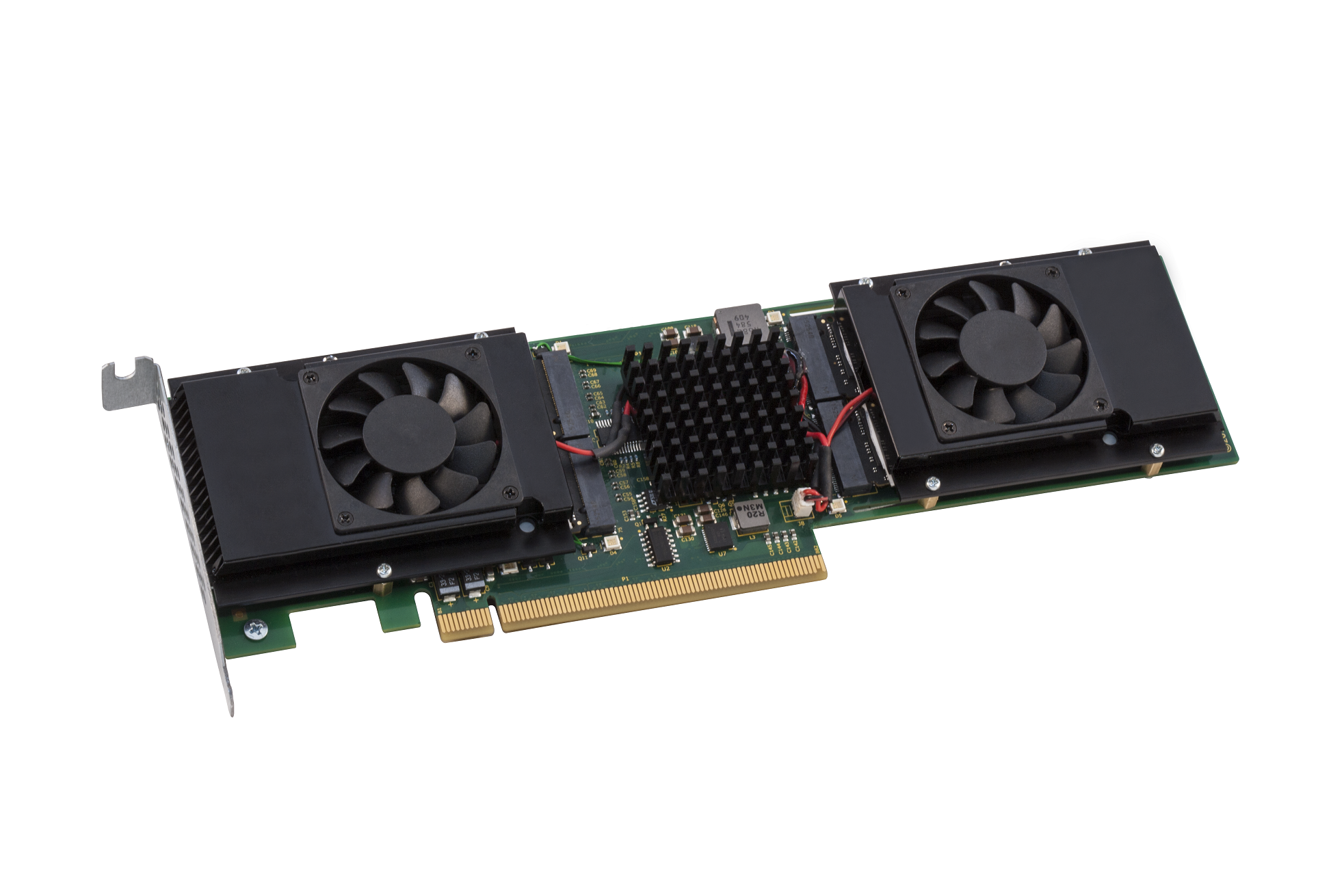
JMR Electronics unveiled the high-performance SiloStor SSD storage cards for audio and video production, graphics and animation. The NVMe/PCIe is available in 512 GB, 1 TB and 2 TB capacities, the dual-drive module up to 4 TB and the full-length quad-drive up to 8 TB; dual- and quad-drive cards incorporate a PCIe switch and can be striped for additional I/O performance. All units incorporate active heatsink coolers to ensure maintaining low operating temperature even during intensive sequential-write operations. Also to be seen: SAS Expander for any BlueStor Servers with up to 16 drives.
Kingston Digital showcased the new MPC1000 PCIe interface for connected solid-state drives that is said to significantly accelerate playback for applications such as Adobe After Effects, with the ability to view uncompressed HD video without data delays, and preview of 3D, 4K, 8K and VR in real time. Also to be seen: the DCP1000 SSD card that delivers up to 1.25 million IOPS from a single drive, with ultra-low transactional latency and high throughput, with a flexible drive topology and support for software RAIDs. Such drives can significantly reduce access delays associated with throughput latency for data-intensive software within the post-production infrastructure.
Sound Devices launched the MixPre Series of lightweight audio recorders with integrated USB audio interface for effects recordists and sound designers. The three-input/five-track MixPre-3 and the six-input/eight-track MixPre-6 feature the firm’s Kashmir ultra-low-noise microphone pre-amps and analog limiters. In addition, the MixPre-6 features XLR/ -inch combo inputs allowing line-input sources to be connected directly. Both models record to SD, SDHC or SDXC media.

And it terms of companion post hardware, Auralex Acoustics has partnered with Broadcast Supply Worldwide to offer its RoomCaster Freestanding Acoustical Treatment System, which is said to provide a cost-effective solution for small edit and mixing suites. Utilizing Auralex Studiofoam, the portable and lightweight package can be implemented in situations where boundary-mounted acoustical treatments are not feasible, and reduces unwanted reverberation and standing waves. The system comprises a pair of 24- by 48-inch and two 24- by 24-inch portable panels available with charcoal, burgundy or purple coverings, together with stands.

BenQ America demonstrated Technicolor color-certified PV270 post monitors with Rec. 709 compliance, plus DCI-P3 color gamut and calibration tools, together PV3200PT video-editing monitors. The 27-inch PV270 display includes brightness uniformity, with 2560×1440 (QHD) resolution for close reviews and detailed editing. A 14-bit 3D LUT and Delta-E of less than or equal to 1.5 is said to ensure an accurate color mixture. The 32-inch PV3200PT features 4K UHD (3840×2160 pixel) resolution and a color gamut that covers 100% Rec. 709/sRGB with hardware calibration support of color gamut, white point, color temperature and luminance.
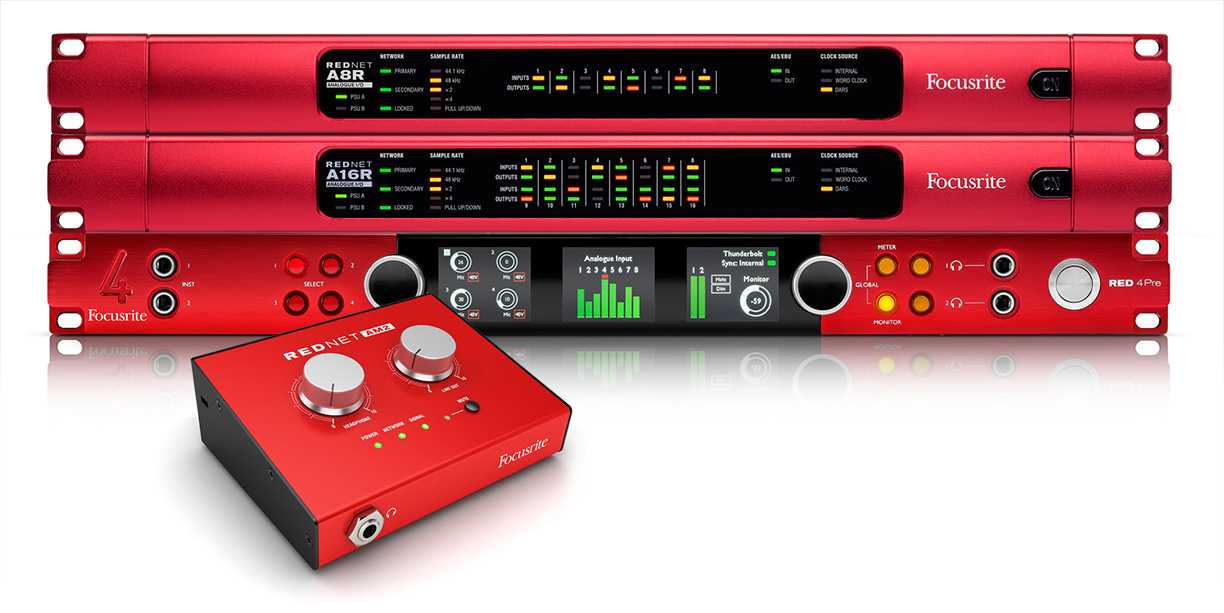
Focusrite showcased the RedNet range of interfaces for direct integration with Avid Pro Tools|HDX via MADI and Audinate Dante audio-over-IP I/Os, with network and power redundancy. The RedNet A16R offers 16 channels of Dante-networked A-to-D and D-to A conversion, while the D64R comprises a 64-channel bridge between MADI- and Dante-format networks, and the HD32R is a 32-channel bridge between Dante Networks and Pro Tools|HD. Also to be seen: the PCIeR Card with network redundancy for low-latency audio and full track count.
Thinklogical introduced an uncompressed 4K private-cloud solution for VFX and post applications which, rather than distributing video and computer I/O control over public networks using IP technology, uses PC-over-IP private cloud to provides zero-latency video, KVM and UI control, plus supports of 4K DCI 4:4:4 sequences, at up to 60 fps. The firm’s patented technology can transport multiple uncompressed 4K streams over a single fiber, at distances of up to 50 miles, enabling a VFX or post facility in New York or Los Angeles to achieve on-premise-quality performance from data centers within their metro region. Also to be seen: HDMI 2.0 Extenders via fiber with no compression or latency.
TVLogic unveiled new reference 4K, OLED and HDR Monitors for post applications, including the LUM-310R 31-inch 4K HDR monitor; the LEM-550R 55-inch UHD OLED HDR monitor for QC and post; and the LVM-171S 17-inch QC-Grade HD dual-channel LCD. The LUM-310R 4096- by 2160-pixel monitor features a local-dimming backlight array designed to reproduce reference HDR content at a maximum luminance of 2,000 nits, with a simultaneous deep black minimum of 0.002 nits, and supports HDR standards such as SMPTE ST2084, ST2086 and ST2094 and Hybrid-Log Gamma, together with Rec.709, DCI-P3, and Rec.2020 color gamuts.
Vertiv unveiled its new Avocent HMX 6000 high-performance, IP-based KVM extender that enables critical computing hardware to be relocated to a secure and temperature-controlled environment remote from a workstation, while maintaining monitor resolutions up to 2560×1600 pixels. Redundant network operation automatically changes to a second network port if a failure is detected. Up to 256-bit AES and RSA 2048 encryption is available, with simultaneous supports for up to 16 users; 300 feet extension distance is available on a single CatX cable and “unlimited” using a standard IP network.
“Once again, The NAB Show is the premier destination for content creators, producers and distributors exploring the evolving world of media, entertainment and technology,” summed up NAB executive vice president of Communications Dennis Wharton. “We thank our exhibitors, program partners, speakers and attendees for their support in making NAB Show the must-attend event for bringing content to life.”



